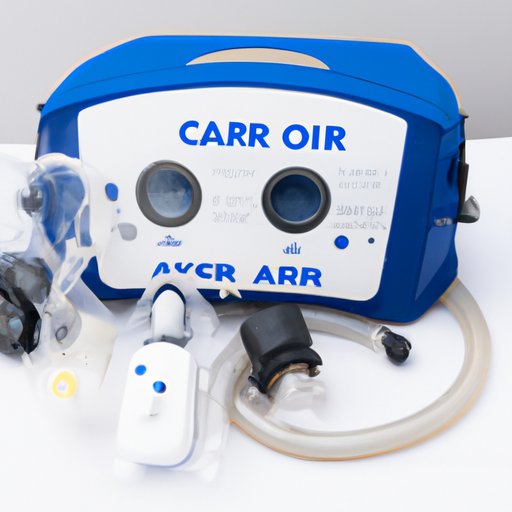Introduction
A CPAP (Continuous Positive Airway Pressure) machine is a device used to treat sleep apnea. It works by delivering a steady stream of pressurized air through a tube and into the user’s nose and/or mouth while they sleep, keeping their airways open. A CPAP machine can help reduce or eliminate snoring, improve sleep quality and make breathing easier.

Explaining the Components of a CPAP Machine and How They Work Together
The components of a CPAP machine include the pressure settings, mask, hose, air filter, and humidifier. Each of these components plays an important role in providing effective treatment for sleep apnea.
Pressure Settings
The pressure settings on a CPAP machine are adjustable, allowing users to find the most comfortable setting for their individual needs. Generally, the higher the pressure setting, the more effective the treatment. The ideal pressure setting is determined by a sleep specialist during a sleep study.
Mask
The mask is the part of the CPAP machine that actually delivers the pressurized air to the user. It is usually made of a soft, flexible material and fits snugly over the user’s nose and/or mouth. There are several different types of masks available, including full face masks, nasal masks, and nasal pillows.
Hose
The hose connects the mask to the CPAP machine and carries the pressurized air from the machine to the user. It is typically made of a flexible material such as rubber or plastic, and is designed to be lightweight and easy to maneuver.
Air Filter
The air filter on a CPAP machine helps keep the air clean and free of dust and other particles. It should be replaced regularly, as it can become clogged with debris over time.
Humidifier
The humidifier adds moisture to the air delivered through the CPAP machine, which helps reduce irritation to the user’s airways. It should be cleaned regularly to prevent bacteria and mold growth.
Outlining the Basics of CPAP Therapy
CPAP therapy is the process of using a CPAP machine to treat sleep apnea. It works by delivering a steady stream of pressurized air through a tube and into the user’s nose and/or mouth while they sleep, keeping their airways open. CPAP therapy can help reduce or eliminate snoring, improve sleep quality, and make breathing easier.
According to research studies, “Using CPAP therapy led to improvements in sleep quality, daytime alertness, and overall quality of life.”1 This is because CPAP therapy helps keep the airways open and prevents them from collapsing, thus allowing the user to breathe more easily and get better quality sleep.
Describing the Benefits of Using a CPAP Machine
There are many benefits to using a CPAP machine. The most common benefits include improved sleep quality, reduced snoring, and better breathing. Improved sleep quality can lead to increased energy levels during the day, improved concentration, and improved mood. Reduced snoring can lead to better relationships, as snoring can disturb partners or roommates. Better breathing can lead to improved overall health, as the user will not be struggling to breathe throughout the night.
Discussing the Different Types of CPAP Machines Available
There are several different types of CPAP machines available. Standard CPAP machines provide a constant flow of air at a set pressure, and are the most commonly used type of CPAP machine. Auto-adjusting CPAP machines automatically adjust the air pressure to match the user’s breathing patterns. Bi-level CPAP machines provide two different air pressures, one for inhalation and one for exhalation.

Examining the Features of a CPAP Machine
When choosing a CPAP machine, it is important to consider the features it offers. Some features to look for include noise levels, data storage, and mask fit. Noise levels can vary greatly between different models, so it is important to choose a machine that is quiet enough to not disturb your sleep. Data storage allows you to track your progress and see how your treatment is progressing. Mask fit is also important, as a poor fitting mask can cause discomfort and leakage.

Providing Tips for Optimal Use of a CPAP Machine
To get the most out of your CPAP machine, there are several tips to keep in mind. First, make sure your mask fits properly and is comfortable to wear. Second, change the air filter regularly to ensure the air is clean and free of dust and other particles. Third, clean the humidifier tank daily to prevent bacteria and mold growth. Finally, keep track of your CPAP data to monitor your progress and ensure you are getting the most out of your treatment.
Conclusion
CPAP machines are an effective way to treat sleep apnea. They work by delivering a steady stream of pressurized air through a tube and into the user’s nose and/or mouth while they sleep, keeping their airways open. CPAP machines have many components, including pressure settings, mask, hose, air filter, and humidifier. CPAP therapy can help reduce or eliminate snoring, improve sleep quality, and make breathing easier. There are several different types of CPAP machines available, each with its own features and benefits. Following the tips outlined above can help ensure optimal use of a CPAP machine.
(Note: Is this article not meeting your expectations? Do you have knowledge or insights to share? Unlock new opportunities and expand your reach by joining our authors team. Click Registration to join us and share your expertise with our readers.)
